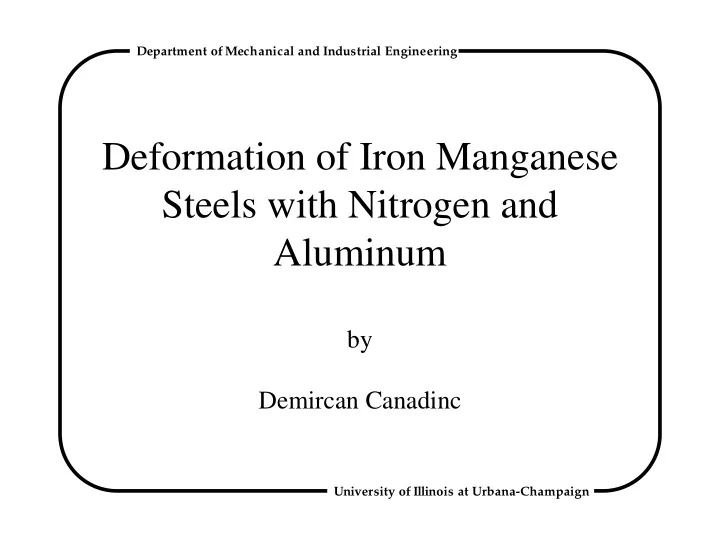

Department of Mechanical and Industrial Engineering Deformation of Iron Manganese Steels with Nitrogen and Aluminum by Demircan Canadinc University of Illinois at Urbana-Champaign
Department of Mechanical and Industrial Engineering Introduction to Hadfield Steel Hadfield Steel: • Excessive deformation and wear resistance requiring applications (e.g.,railroad frogs). • High toughness. • High ductility. • High work hardening capacity. • Work hardening mechanism not fully understood yet. University of Illinois at Urbana-Champaign
Department of Mechanical and Industrial Engineering Hadfield Steel Single Crystals Reasons for using single crystals: • Orientation dependence of mechanical properties, such as yield strength, work hardening, ductility, and toughness. • To go one step further in applications by introducing combination of mechanical properties at a higher level compared to polycrystalline form. University of Illinois at Urbana-Champaign
Department of Mechanical and Industrial Engineering Alloying Hadfield Steel • By alloying Hadfield steel, a new microstructure is introduced. • By changing the microstructure, difference in the deformation mechanisms and accordingly better mechanical properties, such as high strength combined with high ductility and higher rate of work hardening, are aimed. University of Illinois at Urbana-Champaign
Department of Mechanical and Industrial Engineering Effect of Nitrogen on the Deformation Behavior of Hadfield Steel • Work done on nitrogen alloyed stainless steels, previously. • Nitrogen added to Hadfield steel mainly to achieve higher strength. • Work hardening behavior investigated. • In this study, three different compositions compared: 0%N, 0.05%N, 1.06%N (Same amount of C, and Mn). University of Illinois at Urbana-Champaign
Department of Mechanical and Industrial Engineering Hadfield Steel [111] Orientation Single Crystals under Compressive Loading 2000 Hadfield Steel [111] Orientation Compression Tests, T=293 K 1.06% N, 1.09% C, average of 3 tests G/26 0.05% N, 1.04% C, average of 8 tests 1.0% C, average of 7 tests 1500 True Stress (MPa) 1000 G/40 500 G/122 0 0.00 0.05 0.10 0.15 0.20 0.25 0.30 True Inelastic Strain University of Illinois at Urbana-Champaign
Department of Mechanical and Industrial Engineering TEM pictures showing microstructural state of different compositions after deformation University of Illinois at Urbana-Champaign
Department of Mechanical and Industrial Engineering Effect of Nitrogen • Drastic increase in yield strength with increasing nitrogen content. • No significant change in ductility. • Orientation dependence of mechanical properties: Same trend for all three compositions. • Important role of precipitation hardening in increasing the strength. • Significant difference in the deformation behavior of materials with the same crystallographic orientation but different nitrogen contents. University of Illinois at Urbana-Champaign
Department of Mechanical and Industrial Engineering Effect of Aluminum on the Deformation Behavior of Hadfield Steel • Work done on aluminum alloyed Hadfield steel polycrystals with different chemical compositions, previously. • Aluminum added to Hadfield steel mainly to suppress twinning and thereby modify the work hardening behavior. • In this study, two different compositions compared: 0%Al, 2.6%Al (Same amount of C, and Mn). University of Illinois at Urbana-Champaign
Department of Mechanical and Industrial Engineering Hadfield Steel [100] Orientation Single Crystals under Tensile Loading 1200 Hadfield Steel [100] Orientation Tension Tests, T=293 K 2.58%Al, 1.3% C, average of 4 tests 1.3% C, average of 5 tests 1000 G/23 800 True Stress (MPa) 600 400 G/170 200 0 0.0 0.1 0.2 0.3 0.4 0.5 0.6 True Inelastic Strain University of Illinois at Urbana-Champaign
Department of Mechanical and Industrial Engineering TEM pictures showing microstructural state of different compositions after deformation University of Illinois at Urbana-Champaign
Department of Mechanical and Industrial Engineering Effect of Aluminum • Increase in yield strength with increasing aluminum content. • Loss of ductility, but not very brittle. • Orientation dependence of mechanical properties. • Twinning suppressed by alloying with Aluminum. • Significant difference in the work hardening behavior: Coefficient of deformation hardening in stage II increased drastically with Aluminum. University of Illinois at Urbana-Champaign
Department of Mechanical and Industrial Engineering Conclusion • Addition of nitrogen resulted in a drastic increase of mechanical strength without significant change of ductility. • Addition of Aluminum introduced a rapid work hardening combined with relatively higher strength. • Better combination of mechanical properties may be obtained by properly alloying Hadfield steel. • Different combinations of mechanical properties possible with different crystallographic orientations. University of Illinois at Urbana-Champaign
Recommend
More recommend